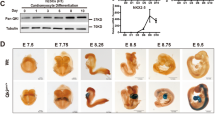Abstract
Heart disease is the number one killer in the USA, making cardiogenesis and its related pathways a relevant area of study for improving health and life expectancy. The Mexican salamander (axolotl), Ambystoma mexicanum, provides an excellent vertebrate animal model for studying myofibrillogenesis due to its naturally occurring cardiac nonfunction mutation. Homozygous recessive embryos do not develop normal hearts due to a lack of myofibril formation. In previous studies, myofibril-inducing ribonucleic acid (MIR) from the normal wild-type axolotl genome was found to rescue mutant nonfunctioning hearts through restoration of tropomyosin levels followed by normal myofibril formation. Our purpose in this study is to identify and characterize functional homologs for the MIR from human fetal heart ribonucleic acid (RNA). After randomized cloning of human fetal heart RNA, 396 clones were analyzed for rescuing ability by using mutant heart rescue bioassays and confocal microscopy. By these analyses, we discovered a functional homolog of MIR from human fetal heart RNA, which is associated with the mitochondrial cytochrome c oxidase subunit II gene. This RNA came from our clone #30 and induces tropomyosin synthesis and myofibrillogenesis in mutant axolotl hearts which ordinarily do not synthesize tropomyosin or form organized myofibrils. Clone #30, a mitochondrial RNA molecule associated with human cytochrome c oxidase, serves as a functional homolog of MIR, leading to tropomyosin production, organized myofibrils, and beating cardiac tissue in mutant hearts. These findings hold great potential for the treatment and repair of damaged hearts in patients who have suffered from myocardial infarctions and other heart diseases.




Similar content being viewed by others
References
Centers for Disease Control and Prevention (2014) “Heart disease facts,” Available: http://www.cdc.gov/heartdisease/facts.htm
LaFrance SM, Fransen ME, Erginel-Unaltuna N, Dube DK, Robertson DR, Stefanu C, Ray TK, Lemanski LF (1993) RNA from normal anterior endoderm/mesoderm-conditioned medium stimulates myofibrillogenesis in developing mutant axolotl hearts. Cell Mol Biol Res 39(6):547–560
Lemanski LF (1973) Morphology of developing heart in cardiac lethal mutant Mexican axolotls, Ambystoma mexicanum. Dev Biol 33(2):312–333
Lemanski LF (1979) Role of tropomyosin in actin filament formation in embryonic salamander heart cells. J Cell Biol 82:227–238
Lemanski LF, Mooseker MS, Peachey LD, Iyengar MR (1976) Studies of muscle proteins in embryonic myocardial cells of cardiac lethal mutant Mexican axolotls (Ambystoma mexicanum) by use of heavy meromyosin binding and sodium dodecyl sulfate polyacrylamide gel electrophoresis. J Cell Biol 68:375–388
Lemanski LF, Zhang C (2007) Promoting cardiac cell differentiation (US Issued Patent [9/18/07] 60/462 171)
Lemanski SF, Kovacs CP, Lemanski LF (1997) Analysis of the three-dimensional distributions of α-actinin, ankyrin and filamin in developing hearts of normal and cardiac mutant axolotls, Ambystoma mexicanum. Anat Embryol 195:155–163
Parker S (2012) Cardiovascular disease the facts. Health Guidance. Available: http://www.healthguidance.org/entry/6324/1/Cardiovascular-Disease-The-Facts.html
Rueda-de-Leon E, Kochegarov A, Lian W, Athauda G, Zhang C, Maier J, Huang X, Achary MP, Moses A, Meyer J, Arms JD, Burlbaw SR, Lemanski SL, Lemanski LF (2011) Human heart RNA promotes tropomyosin synthesis and myofibrillogenesis in mutant axolotl hearts. MD-Med Data 3(3):223–227
Zajdel RW, McLean MD, Lemanski SL, Muthuchamy M, Wieczorek DF, Lemanski LF, Dube DK (1999) Ectopic expression of tropomyosin in cardiac mutant axolotl hearts promotes organized myofibril formation. Dev Dynamics 213:412–420
Zhang C, Jia P, Huang X, Sferrazza GF, Athauda G, Achary MP, Wang J, Lemanski SL, Dube DK, Lemanski LF (2009) Myofibril-inducing RNA (MIR) is essential for tropomyosin expression and myofibrillogenesis in axolotl hearts. J Biom Sci 16:81. doi:10.1186/1423-0127-16-81
Zhang C, Pietras KM, Sferrazza GF, Jia P, Athauda G, Rueda-de-Leon E, Maier JA, Dube DK, Lemanski SL, Lemanski LF (2007) Molecular and immunohistochemical analyses of cardiac troponin T during cardiac development on the Mexican axolotl, Ambystoma mexicanum. J Cell Biochem 100:1–15
Acknowledgments
This research was made possible through grants funded by the American Heart Association (AHA) and the National Institutes of Health (NIH grants HL61246 and HL58435), and in part, by a National Science Foundation (NSF grant NSFRUI1121151) awarded to Dr. Larry Lemanski. We are grateful to Ms. Adenike Ogunpeju, Ms. Cheryl Strube, Ms. Mallory Dennie, and Ms. Sharon Lemanski for excellent secretarial and administrative assistance in the preparation of this manuscript for publication.
Author information
Authors and Affiliations
Corresponding author
Additional information
Editor: T. Okamoto
Rights and permissions
About this article
Cite this article
Moses-Arms, A., Kochegarov, A., Arms, J. et al. Identification of a human mitochondrial RNA that promotes tropomyosin synthesis and myocardial differentiation. In Vitro Cell.Dev.Biol.-Animal 51, 273–280 (2015). https://doi.org/10.1007/s11626-014-9834-2
Received:
Accepted:
Published:
Issue Date:
DOI: https://doi.org/10.1007/s11626-014-9834-2




